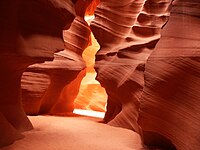Canyon (geomorphology)

In geomorphology and geology, a canyon or cañadón is a geographical accident caused by a river that through a process of epigenesis excavates a deep fissure in sedimentary land nearly vertical walls. A riverbed will gradually reach a reference elevation, which is the same elevation as the body of water into which the river flows. Weathering and erosion processes will form canyons when the headwaters and estuary of the river are at significantly different elevations, particularly through regions where softer rock layers intermingle with harder, more weather-resistant layers. It is, therefore, a kind of gorge widened by the long action of the processes of ice erosion. When the canyon is very narrow, just over a couple of meters, it is known as a slot canyon.
Other origins of the cannons are:
- Castic cannons, produced by the incision of a river current plus karstification.
- Guns associated with fractures, in which there can also be karstification or a change in the base level.
- Structural cannons, such as the cluses produced in the apalachanos reliefs.
In general, tabular reliefs favor the presence of deep canyons associated with fractures, as occurs with gorges in limestone or karstic terrain.
Training
Most canyons were formed by a long process of erosion from a plateau or plateau level. Cliffs are formed because harder rock strata that are resistant to erosion and weathering remain exposed on the valley walls.
Canyons are much more common in arid areas than in humid areas because physical weathering has a more localized effect in arid areas. Wind and river water combine to erode and cut less resistant materials such as shale. The freezing and expansion of water also serve to help form canyons. Water seeps into the cracks between the rocks and freezes, separating the rocks and eventually causing large chunks to break off the canyon walls, in a process known as frost wedges. Canyon walls are often made up of strong sandstone or granite.
Sometimes large rivers traverse canyons as a result of gradual geological uplift. These are called entrenched rivers, because they cannot easily alter their course. In the United States, the Colorado River in the Southwest and the Snake River in the Northwest are two examples of tectonic uplift.
Canyons often form in areas of limestone rock. Since limestone is soluble to some extent, cave systems form in the rock. When a cave system collapses, a canyon remains, as in the Mendip Hills in Somerset and the Yorkshire Dales in Yorkshire, England.
Examples of cannons
In North America
- Huentitan rod, in the state of Jalisco, in the west of Mexico;
- Metztitlán rod, in the state of Hidalgo, in the center of Mexico;
- Copper rods, in the state of Chihuahua, north of Mexico;
- Sumidero Canyon, in the state of Chiapas, Mexico, with almost 1000 m depth;
- Cañón el Calabozo, in Monterrey, Nuevo León, Mexico;
- Nozzle Canyon, in the state of Coahuila, Mexico;
- Cañón de Santa Elena, in the state of Chihuahua, Mexico;
- Colorado cannon, west of the United States, with almost 1500 m depth;
- Gunnison Black Canyon National Park;
- Bryce Canyon, Utah State, also west of the United States;
- Yellowstone River Canyon, Wyoming, United States;
- Desfiladero del Río Grande;
- Niagara River Gorge;
- Columbia River Gorge;
In Europe
- Ebro Canyon in Burgos Province.
- Lobos River Canyon, Burgos and Soria Provinces, Spain;
- Almadenes Canyon, formed by the Segura River in Cieza and Calasparra Province of Murcia, Spain;
- Gorges of the Tarn River in France;
- Arribes del Duero, in the provinces of Salamanca and Zamora (Spain) and the districts of Guarda and Braganza (Portugal);
- Garganta del Verdón (France)
- Arrazas Canyon (Huesca)
- Añisclo Canyon (Huesca)
- Cañón del Júcar (Valencia)
- Tara River Canyon (Montenegro)
In Asia
- Sianok Canyon in Bukittinggi, Western Sumatra, Indonesia;
- Qutang, one of the Three Yangtse River Gorges in China;
- Yarlung Tsangpo River Pendant or upper section of the Brahmaputra, the deepest in the world, in Tibet, China;
In South America
- Itaimbezinho Canyon, in the national park of Aparados da Serra, Rio Grande del Sur, Brazil.
- Cajón del Maipo, in Chile, Andean cannon in the commune of San José de Maipo.
- Atuel Canyon, Mendoza, Argentina.
- Cañón del Pilaya, between departments of Chuquisaca and Tarija, Bolivia.
- Apurímac Canyon, between the departments of Apurímac and Cusco with 4691 m is the deepest in Peru and the second in the world.
- Garganta del río Majes, in Peru, almost twice as deep as the Grand Canyon of the Colorado;
- Cotahuasi Canyon in Arequipa region, Peru with 3535 m depth;
- Colca Canyon, in Arequipa region, Peru, with 4160 m of maximum depth.
- Duck Canyon in the Áncash region in Peru;
- Marañón Canyon, between the departments of Áncash and Huánuco, in Peru, with a depth of 1900 meters;
- Cañón del Chicamocha, in Santander, Colombia, with 2000 m depth;
- Saturban Canyon, Santander, Colombia;
- Hidrosogamoso Canyon in Santander, Colombia;
- Combeima Canyon, in Tolima, Colombia;
- Cañón de las Gachas, in Santander, Colombia;
- Gold River Canyon, Santander, Colombia;
- Devil Canyon, Bolivar State (Venezuela);
- Kavak River, west of the Auyantepui, in the Bolivar state (Venezuela);
In Central America
- Somoto Canyon, in the department of Madriz, Nicaragua.
- San Cristobal Canyon, in the municipality of Barranquitas, Puerto Rico.
Contenido relacionado
The Forest (Spain)
Trans siberian
Barceo





